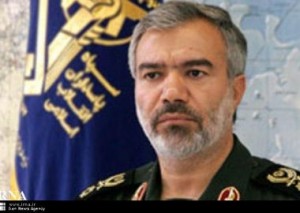 TEHRAN (FNA)- Islamic Revolution Guards Corps (IRGC) Navy Commander Rear Admiral Ali Fadavi underlined that Iran's missile power is dissuading the US from continued deployment of its forces in the Persian Gulf region.
TEHRAN (FNA)- Islamic Revolution Guards Corps (IRGC) Navy Commander Rear Admiral Ali Fadavi underlined that Iran's missile power is dissuading the US from continued deployment of its forces in the Persian Gulf region."All the capabilities of our Armed Forces directly or indirectly affect our confrontation with the enemy and we should acknowledge that the Americans are a sea-based military power and the Persian Gulf is the most important point of the world and they have no way but being present in this region in order for their continued domination," Fadavi told reporters in Tehran on Monday.
"But the Persian Gulf belongs to the regional countries and Iran is considered as a powerful and influential country in this region, and the US cannot obtain its goal through its present path and has no way but leaving the Persian Gulf, and our missile capability is an influential factor in this issue," he added.
In relevant remarks late September, Deputy Chief of Staff of the Iranian Armed Forces Major General Mostafa Izadi underlined the high capabilities and power of Iran's missiles, and said the enemy feels intense fear of Iran's missile power.
"Iran's defensive industry has made growing progress and the Islamic Republic of Iran's missile power trembles the enemy's backbone," Izadi said, addressing the Defense Ministry's personnel in Tehran.
Tehran launched an arms development program during the 1980-88 Iraqi imposed war on Iran to compensate for a US weapons embargo. Since 1992, Iran has produced its own tanks, armored personnel carriers, missiles and fighter planes.
Yet, Iranian officials have always stressed that the country's military and arms programs serve defensive purposes and should not be perceived as a threat to any other country.
The Iranian Armed Forces have recently test-fired different types of newly-developed missiles and torpedoes and tested a large number of home-made weapons, tools and equipment, including submarines, military ships, artillery, choppers, aircrafts, UAVs and air defense and electronic systems, during massive military drills.
Defense analysts and military observers say that Iran's wargames and its advancements in weapons production have proved as a deterrent factor.
Iran successfully tested second generation of Sejjil missiles and brought it into mass production in 2013.
Sejjil missiles are considered as the third generation of Iran-made long-range missiles.
Also, Iran's 2000km-range, liquid-fuel, Qadr F ballistic missile can reach territories as far as Israel.
Iran's surface-to-surface Sejjil missile, the long-range Shahab-3 ballistic missile which has a range of up to 2,000 km, and Zelzal and Fateh missiles have all been developed by the Aerospace Organization of the Defense Industries.
This is while the solid-fuel, two-stage Sejjil missile with two engines, is capable of reaching a very high altitude and therefore has a longer range than that of the Shahab 3 model.
By�Fars News Agency
The Iran Project is not responsible for the content of quoted articles.










